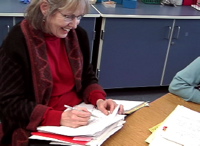Sue Lampkin - Mountain View, California - Kenneth E. Slater Elementary School
SEND FEEDBACK ABOUT THIS WEBSITE!
VIDEO HELP
Sue Lampkin and Slater School
Reflecting about Teaching and Learning
To view the videos on this site, you will need to download and install the following: QuickTime Player 6 or higher or Windows Media Player 9 or higher. Older versions of these players will not support the video media files on this site. You may also need Acrobat Reader (for PDF documents) and the Flash Player (for assorted other media files).
Case Development:
The Carnegie Foundation for the Advancement of Teaching
|
After graduating from the University of Illinois with a BA in Elementary Education and teaching fourth grade for three years in Champaign, Illinois, I moved to Philadelphia where I earned a Masters in Education from Temple University. In Philadelphia I taught in a private preschool/ kindergarten for fifteen years followed by ten years teaching Headstart and kindergarten in the Philadelphia public schools. After moving to California I accepted a K/1 teaching position at Slater Elementary in Mountain View as part of the PACT parent participation program. Our principal, Nicki Smith, a forward thinker, invited Liping Ma and Matt Ellinger to work with the entire K/1 team, both neighborhood and PACT. As Liping and Matt began working with us, I began to realize just how much I didn’t know about teaching math. In the past, I had taught math following publisher’s curriculum guides and accompanying workbooks. Later in California I planned separate units of study using a vJune 5, 2006 integrate all of the state K/1 standards. At times the complexity of teaching math seemed overwhelming. When Liping introduced the idea of “making many few”, that concept helped open my eyes to new ways of teaching math. As we looked at the standards, prioritizing and regrouping them to make the many into few, we realized that most of the first grade standards could be taught by focusing on number sense with addition and subtraction. "Making many few" also relates to teaching children number facts. Rather than focusing on 3 + 2 = 5, 2 + 3 = 5, 5 - 3 = 2, and 5 - 2 = 3 as four different facts, children learn that “3 and 2 make 5” and see the relationship of those numbers in both addition and subtraction. This builds a greater depth of conceptual knowledge than learning four isolated facts. This technique is used to study all the number families from two to ten, repeatedly reinforcing the concept of “making many few”. Prior to studying with Liping Ma I didn’t understand the importance of students knowing how to make and break combinations of ten. When children have progressed to adding and subtracting “teen numbers”, if they know that ten is made with eight and two, and are learning to solving the equation, 8 + 5 = ?, and if they know five is made with two and three, then they can more easily see that 8 + 2 = 10 and 10 + 3 = 13. Similarly if students are solving the problem 13 - 5 = 8, the same skill is valuable in the inverse. As I continue to reflect upon what I discovered with Liping, I recognize the power of the models she presented that increased my own understanding of addition and subtraction word problems. I knew that solving word problems was not an easy task for children, but I was unclear on how to teach problem solving skills. Liping’s models of the three different types of addition problems and their matching types of subtraction problems enable me to teach students to understand the kind of word problem they are solving. Additionally, I now understand the levels of complexity of the different types of word problems, so that I can introduce the correct type of problem to students to sequentially build their problem solving skills with the right level of difficulty at the right time. Knowledge of the models also allows me to construct my own word problems around the students’ interests as well as social studies and science units the class is currently studying. As a result of working with Liping, I've grown to have a better understanding of how to teach math to first graders. I appreciate learning a logical progression of teaching steps that lead children to a greater depth of knowledge. Two years of studying with Liping and Matt have shown me how much there is to learn about teaching math and how many things I didn’t know (and didn’t know I didn’t know!). I’m certain I have much more to learn, but with the models that we’ve started to use and the knowledge we’ve gained in seminars and lesson study, I’m confident that my colleagues and I will continue to share our quest for improving our math lessons. I appreciate having had the opportunity to gain a greater understanding of how to teach math to first graders. |
|||||||||||||||


